Physical Address
304 North Cardinal St.
Dorchester Center, MA 02124
Physical Address
304 North Cardinal St.
Dorchester Center, MA 02124
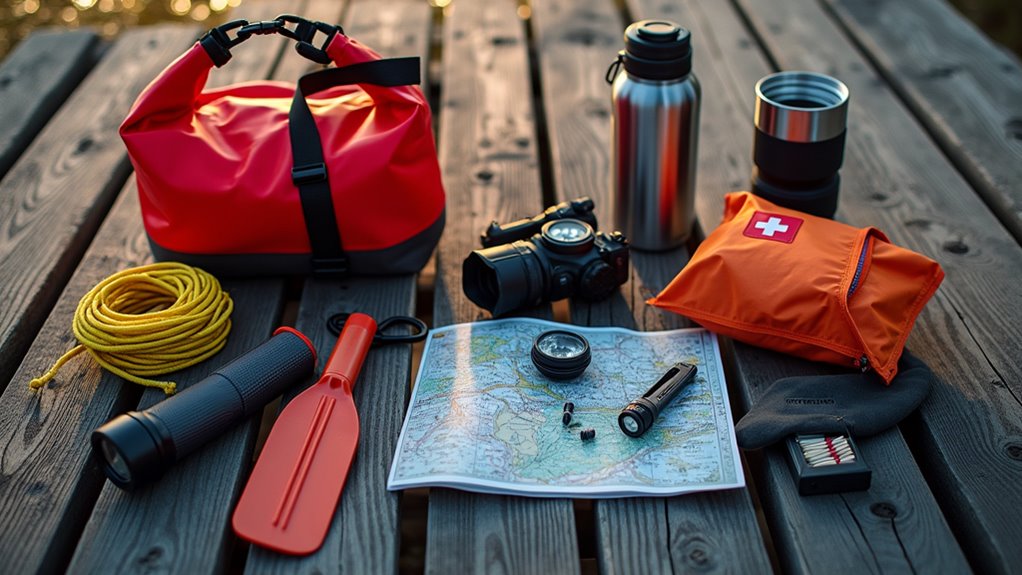
Incredible canoe adventures start with these 12 essential items - but the most important one isn't what you'd expect.
You’re planning your first canoe trip, but you’re not sure what to pack without breaking the bank. Smart packing makes the difference between a memorable adventure and a miserable experience stuck in the wilderness. While you don’t need the most expensive gear, there are twelve essential items you absolutely can’t leave behind – and some might surprise you. Get these basics right, and you’ll handle whatever the water throws at you.

Before you even think about paddles or snacks, you’ll need a properly fitted personal flotation device (PFD) – it’s not just smart, it’s legally required in most areas. Don’t cheap out here; your life depends on it. Choose a Coast Guard-approved Type III PFD for comfort and mobility while paddling. It should fit snugly without restricting movement – you can’t swim effectively if it’s too loose.
Attach a safety whistle to your PFD using the built-in attachment loop. Three sharp blasts signal distress and carry much farther than your voice. Pealess whistles work best since they won’t freeze or clog with water. You can find reliable options for under $5. Test your whistle before each trip – a silent whistle won’t save you. Whether you’re planning a canoe trip or any other family camping adventure, having proper safety equipment should always be your top priority.
While your PFD keeps you safe, your paddle keeps you moving – and you’ll want a backup in case you lose or break your primary paddle. Choose paddles that match your height and paddling style.
For canoe trips, straight-shaft paddles work well for most paddlers and cost less than bent-shaft options.
Your primary paddle should feel comfortable in your hands with a blade size that doesn’t strain your shoulders.
A well-fitted paddle prevents fatigue and shoulder strain during long paddling sessions on the water.
Store your backup paddle where you can reach it quickly – many paddlers secure it under the gunwales with bungee cords or clips.
Don’t skimp on paddle quality, but you don’t need expensive carbon fiber.
Solid wood or aluminum paddles offer good durability at reasonable prices and will serve you well on recreational trips.
If you’re planning a family canoe adventure, consider getting kids camping gear that’s properly sized for younger paddlers to ensure everyone stays comfortable and engaged.
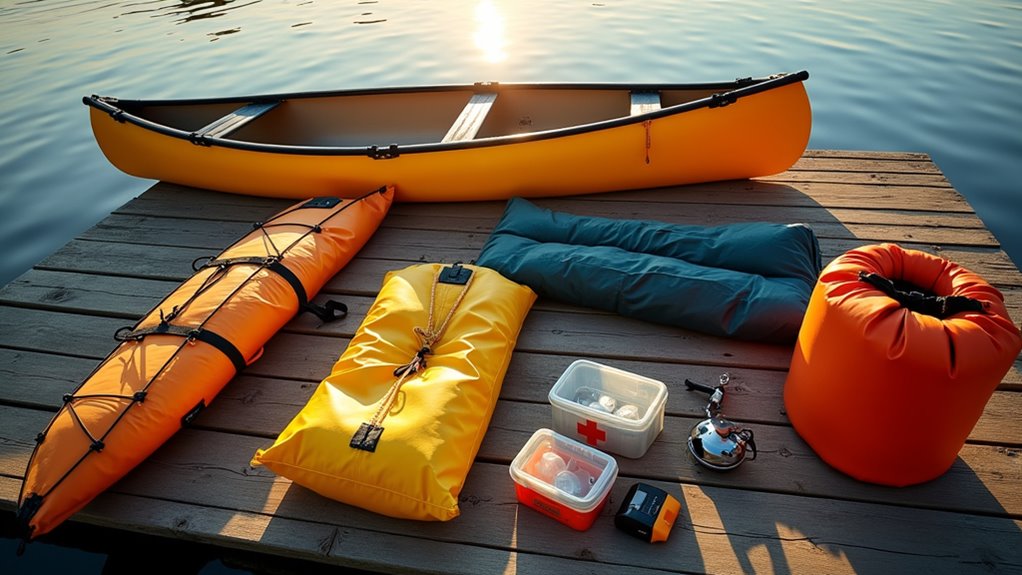
Nothing ruins a canoe trip faster than soggy gear, so you’ll need reliable waterproof storage to keep your essentials dry. Invest in quality dry bags of various sizes – they’re worth every penny. Roll-top dry bags work best for clothes, sleeping bags, and electronics.
Clear waterproof cases protect phones, cameras, and maps while keeping them accessible.
Don’t forget a waterproof container for food. Hard-sided options resist critter damage better than soft bags. Pack items in multiple smaller bags rather than one giant one – it’s easier to organize and retrieve gear.
Test your waterproof storage before departing. Submerge sealed bags in your bathtub to check for leaks. Budget-friendly options include zip-lock bags inside regular stuff sacks, though they’re less reliable than purpose-built dry storage.
Consider packing a reliable camping water filter in your waterproof gear since clean drinking water is essential for safe hydration during multi-day canoe trips.
Even with GPS on your phone, you’ll need backup navigation tools when paddling remote waterways where cell service disappears. Pack a waterproof topographic map of your route in a clear map case – they’re cheap insurance against getting lost.
A basic compass doesn’t need batteries and works when electronics fail. Learn to use both together before your trip.
Download offline maps to your phone as an extra backup. Consider a handheld GPS unit for multi-day expeditions, though they’re pricier.
Don’t forget a pencil to mark your progress on paper maps – pens can leak or freeze.
Study your route beforehand, noting landmarks, portages, and campsites. Mark potential hazards like rapids or shallow areas you’ll want to avoid.
If you’re planning to combine your paddling adventure with a road trip, consider renting an RV as your base camp for accessing multiple waterways along your route.
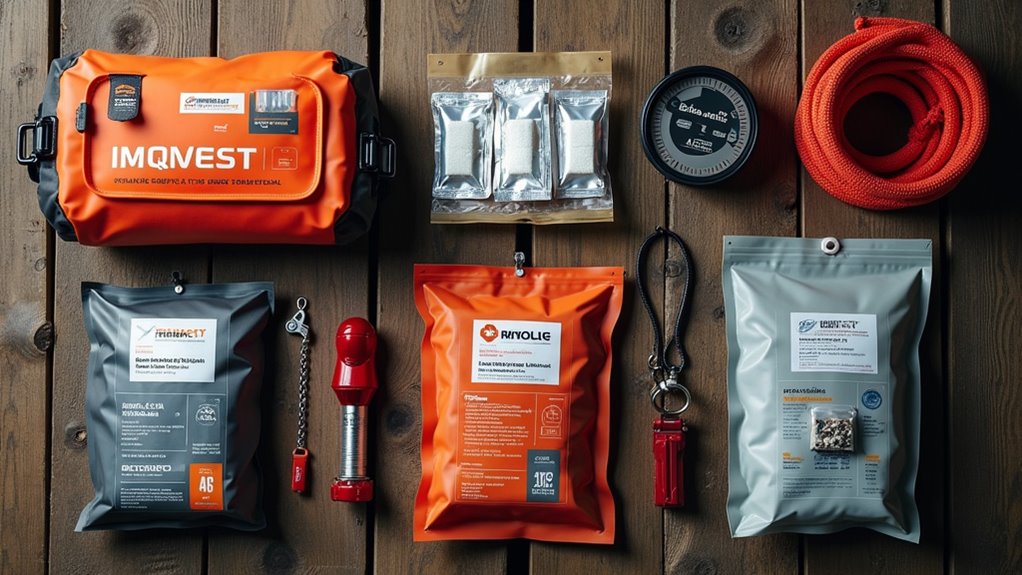
When you’re hours from the nearest hospital, a well-stocked first aid kit becomes your lifeline on the water. Pack bandages, antiseptic wipes, pain relievers, and any personal medications in a waterproof container. Don’t forget tweezers for splinter removal and tape for securing bandages.
Beyond basic medical supplies, you’ll need emergency gear. A whistle can signal for help when your voice won’t carry. Emergency blankets are lightweight and retain body heat if someone gets hypothermic. Pack a headlamp with extra batteries—canoe accidents don’t wait for daylight.
Consider a backup communication device like a satellite messenger if you’re paddling remote areas. It’s pricier than a whistle, but invaluable for serious emergencies. Remember: you can’t treat what you don’t have supplies for.
If you’re bringing children on your canoe trip, pack extra entertainment items to keep them engaged during rest stops, as camping activities can help maintain morale during challenging situations.
Since water acts like a mirror, reflecting UV rays back at your face, you’ll get sunburned faster on a canoe trip than hiking through the woods. Pack broad-spectrum sunscreen (SPF 30+), a wide-brimmed hat that won’t blow off, and polarized sunglasses with a retainer strap.
You’ll need layered clothing for changing weather. Bring a waterproof rain jacket and pants – they’re essential, not optional. Pack a warm fleece or wool layer since temperatures drop on water. Quick-dry shirts and pants work better than cotton, which stays wet and cold.
A lightweight tarp provides extra shelter if you’re caught in storms. Don’t forget lip balm with SPF protection. Your lips burn easily on water and healing takes forever when they’re constantly exposed. Extended sun exposure combined with physical activity increases your risk of dehydration while camping, so proper sun protection becomes even more critical on multi-day canoe trips.
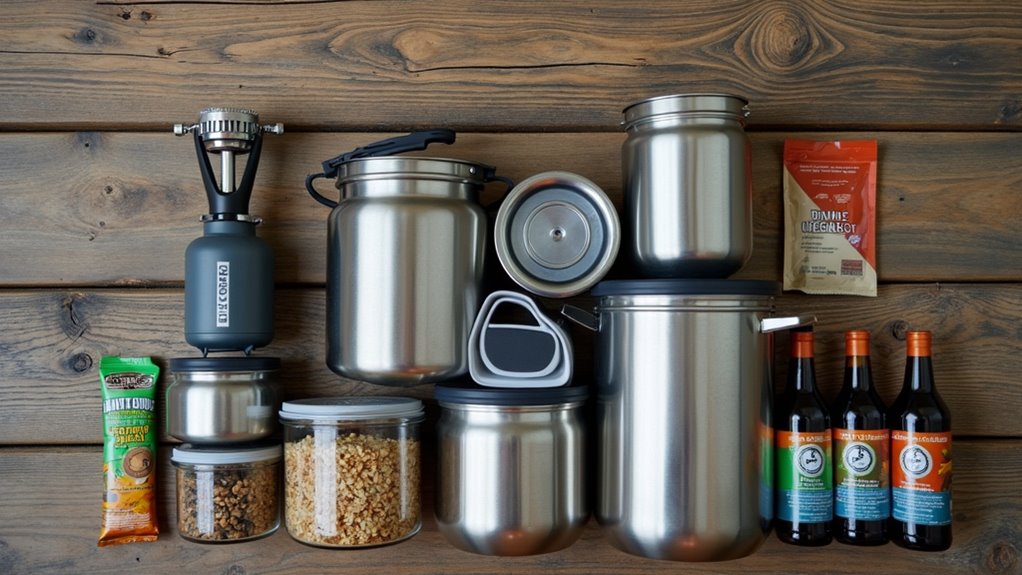
Planning meals for a canoe trip requires balancing nutrition, weight, and storage space in your limited pack. You’ll want lightweight, non-perishable foods that pack plenty of calories. Instant oatmeal, dried fruits, nuts, and jerky make excellent breakfast and snack options.
For dinners, consider one-pot pasta meals, rice dishes, or dehydrated camping meals.
Pack a lightweight camping stove with extra fuel canisters, since campfire restrictions may apply. You’ll need a compact pot set, lightweight utensils, and collapsible bowls.
Don’t forget a sharp knife for food prep and a can opener if needed.
Bring plenty of water purification tablets or a portable filter, plus extra water bottles. Pack all food in waterproof containers or dry bags to prevent spoilage. Consider planning some family camping activities around mealtime to keep everyone engaged while food is being prepared.
While food keeps you fueled, clean drinking water keeps you alive on the water. You’ll need at least one gallon per person per day, but carrying that much weight isn’t practical for longer trips.
Pack a reliable water purification system instead. Water purification tablets are lightweight and cheap – they’ll handle most bacteria and viruses. A portable water filter works faster and tastes better, though it costs more upfront. Boiling water‘s always an option if you’ve got fuel to spare.
Bring collapsible water containers to save space when empty. Don’t forget a backup purification method – tablets weigh nothing and could save your trip if your primary filter breaks. Test everything at home first. Proper campsite navigation skills will help you locate reliable water sources near your camp while avoiding contaminated areas.
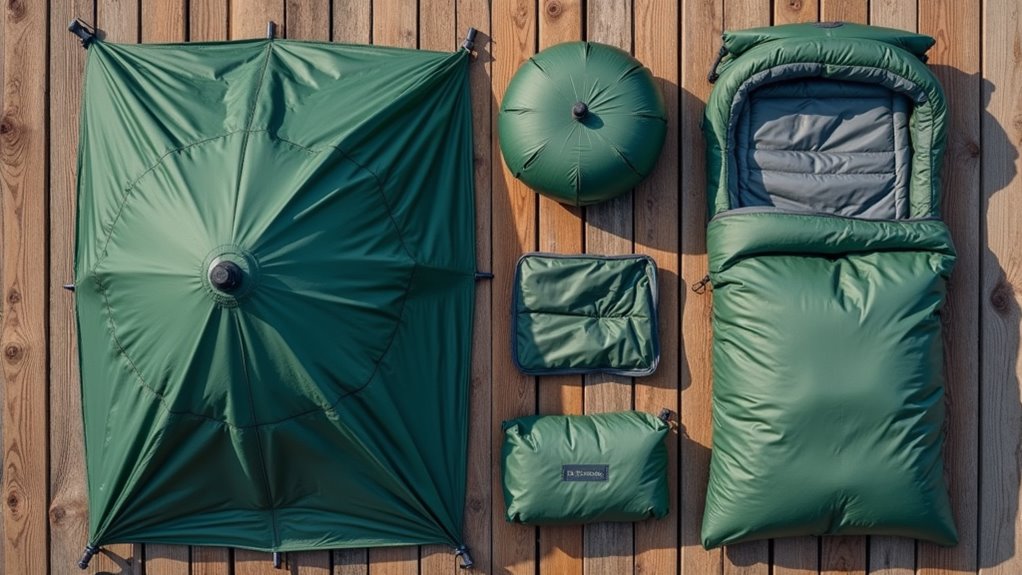
Your shelter system makes the difference between a comfortable night’s sleep and a miserable, sleepless ordeal on the water. Pack a lightweight, waterproof tent that’s easy to set up in windy conditions. Look for models with a full rainfly and vestibule for gear storage.
Your sleeping bag should match expected temperatures. Down insulation packs smaller but loses warmth when wet, while synthetic fills perform better in damp conditions. Don’t forget a sleeping pad – it’s vital for insulation from cold ground and adds comfort on hard surfaces.
Bring a tarp as backup shelter and ground cover. It’s versatile for cooking areas or emergency situations. Consider a pillow or inflatable option for better sleep quality without adding significant weight to your pack.
Research the latest camping gear reviews to ensure you’re selecting the most reliable and tested equipment for your canoe trip.
Once you’ve got your shelter sorted, smart clothing choices will keep you dry, warm, and comfortable throughout your paddling adventure. Pack moisture-wicking base layers instead of cotton—synthetic materials or merino wool dry faster and retain warmth when wet.
Bring a lightweight fleece or down jacket for chilly evenings around camp.
You’ll need a waterproof rain jacket and pants for unexpected downpours. Quick-dry shorts and pants work better than jeans, which stay soggy for hours.
Don’t forget extra socks and underwear—wet feet lead to blisters and misery.
A sun hat protects your face during long paddle days, while a warm beanie handles cool mornings.
Pack everything in waterproof stuff sacks to keep backup clothes bone-dry when you need them most. Planning the right clothing can enhance any of your summer outdoor adventures and make your canoe trip more enjoyable.

When something breaks miles from civilization, a quality multi-tool becomes your best friend on the water. Pack one with pliers, knife, screwdrivers, and scissors – you’ll use these tools more than you’d expect. Don’t splurge on premium brands; a reliable mid-range option works perfectly.
Your repair kit should cover common failures. Include duct tape wrapped around a pencil to save space, zip ties for quick fixes, and marine-grade epoxy putty for serious hull repairs. Pack extra screws and bolts that match your paddle ferrules and seat hardware.
Add paracord, safety pins, and a small sewing kit for gear repairs. Waterproof matches or a backup lighter rounds out your kit. Store everything in a waterproof bag that’s easily accessible – you won’t want to dig through packed gear during an emergency repair. Before heading out, consider what camping style best matches your skill level and comfort preferences to ensure you pack the right repair gear for your specific trip type.
Although sunrise and sunset provide natural bookends to paddling days, you’ll need reliable lighting for early morning departures, evening camp setup, and nighttime necessities. A quality headlamp tops your lighting priorities—it keeps your hands free while you’re setting up camp, cooking, or orienting gear in darkness. Look for models with adjustable brightness and red-light options to preserve night vision.
Pack backup lighting like a small flashlight or backup headlamp in case your primary light fails. Don’t forget extra batteries or a portable power bank for rechargeable lights. Consider a lightweight lantern for ambient camp lighting—it creates a comfortable gathering space and reduces eye strain.
Test all lighting equipment before your trip and store batteries separately to prevent accidental drainage.
Think of your canoe trip like Noah’s ark – you’re carrying everything needed to survive on the water. Don’t let missing essentials sink your adventure before it starts. These twelve items aren’t just suggestions; they’re your lifeline when nature tests your limits. Pack smart, stay safe, and remember – it’s better to have gear you don’t need than need gear you don’t have. Your wallet and your life will thank you.